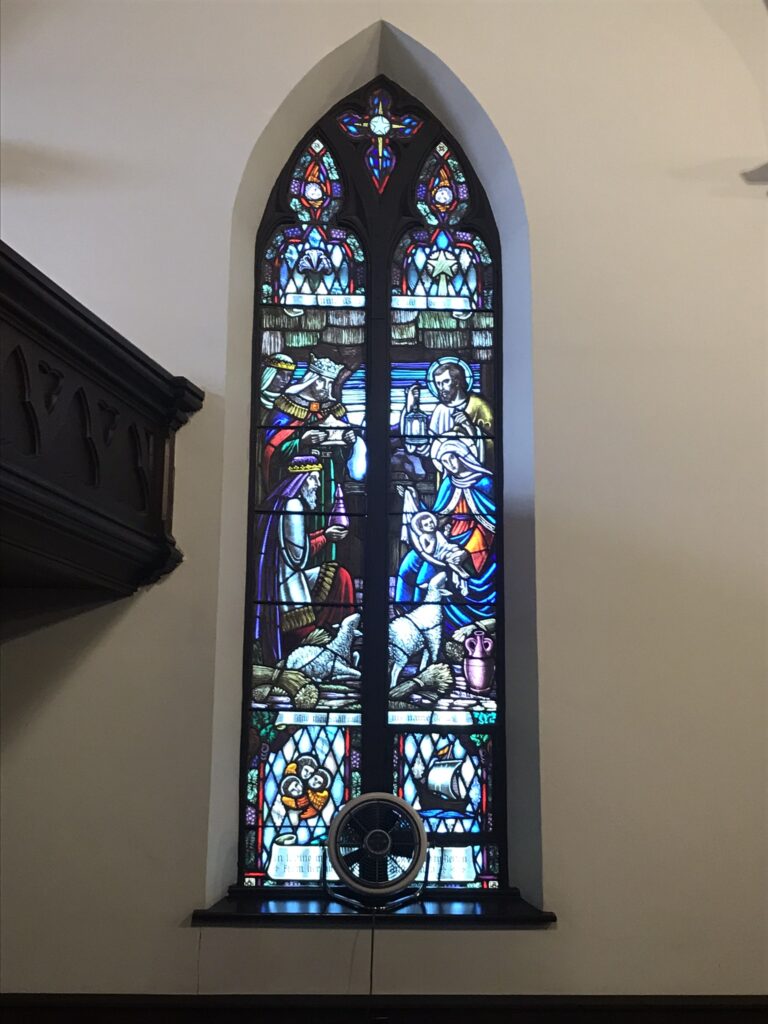The first St. Andrew’s Church was built in 1841 on part of the property our present church building occupies. That church was a plain brick building with wooden pew boxes, a high pulpit at the north end, and neither choir nor organ loft, since music and singing hymns were not part of of worship in the Church of Scotland at that time.
The present St. Andrew’s Church was built in 1867. Canada’s second Prime Minister, Alexander Mackenzie, who worked as a brick layer before his political career, helped to build this church, and was buried from it at his death in 1892. We became St. Andrew’s Presbyterian Church in 1875, upon joining the Presbyterian Church in Canada denomination.
St. Andrew’s was designed by Scottish-born American architect James Anderson. The tall copper steeple, pointed arches, narrow windows, spires and buttresses reflect the Gothic revival designs popular in European churches and cathedrals. Over the years, the congregation has written its own history into the walls and windows of St. Andrew’s.
St. Andrew’s oldest stained glass window is located in the Watson Fellowship Room, facing Front Street. Originally installed in the first St. Andrew’s Church, this vibrantly coloured window dates to 1841 and is believed to be the oldest stained glass window in Sarnia. The undedicated windows in the sanctuary date to the time of the building’s construction, circa 1867. The sketch below shows the order of the nine dedicated windows in the sanctuary.
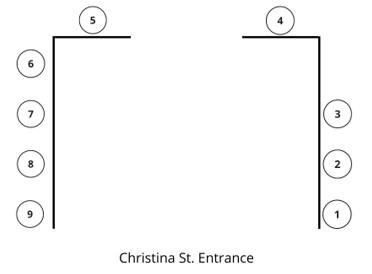
1. The McGibbon Window was dedicated on Dec. 30, 1990.
This window honours John H. and Annie Della McGibbon. It was dedicated by their children Mary-Lou, Donald John and John H., Jr., in time for St. Andrew’s 150th Anniversary year. This window stresses the importance of music, with the lyre, and two winged angel musicians in the uppermost panes. One angel plays the trumpet and the other sings. The main body of the window shows King David, on the left, a singer and writer of Psalms. On the right, St. Cecelia is shown. It was said that she played all instruments, invented the organ, and composed hymns. Today, she is considered a patron saint of music and musicians. Trumpets and cymbals appear on the bottom section of the window.
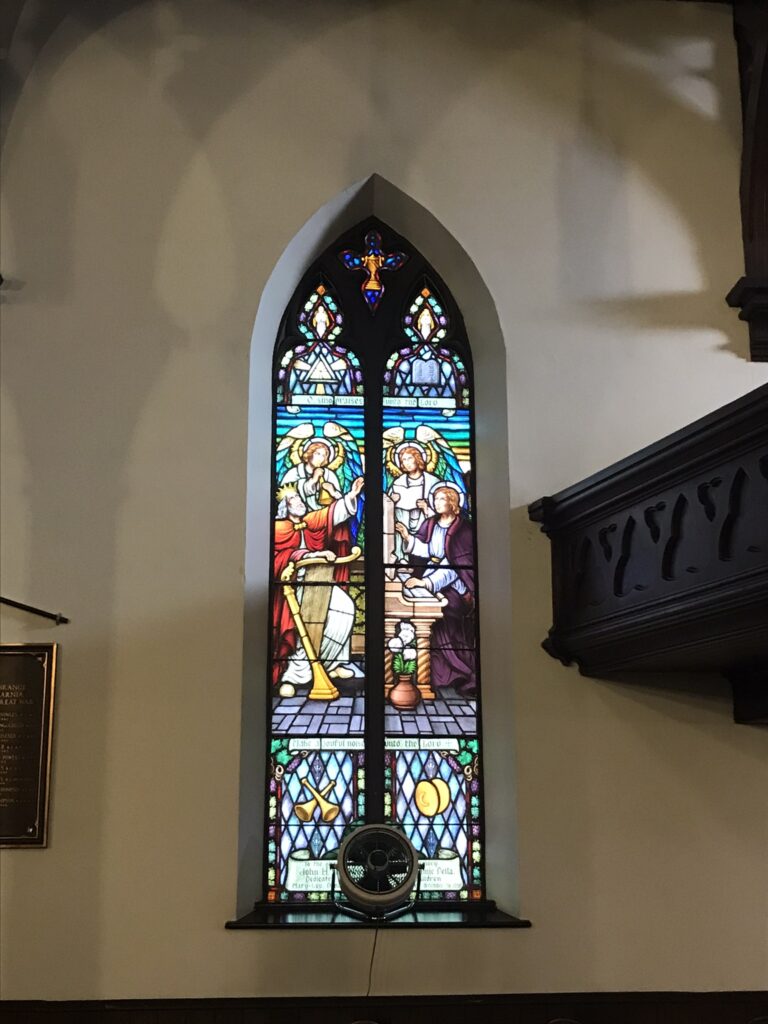
2. The Lockhart Window was installed in 1964.
The window was donated by the family of Homer J. Lockhart, Senor Elder. In the uppermost section of the window is the Celtic or Ionic Cross, used by early Christians in Scotland. In the upper panes, there are two winged angels. Below and to the left is a crown, which refers to Christ’s kingship, victory and our reward for a life of Christian faith. To the right, a lighted lamp shines on an open book, representing Christ’s wise and knowledgeable teaching. The centre of the window shows young Jesus in the Temple with the teachers of the Jewish Law, and Mary and Joseph in the background. The bottom section shows the Christogram became “IHC”, denoting the first three letters of the Greek name of Jesus, ΙΗΣΟΥΣ, and an open Bible in front of a Cross.
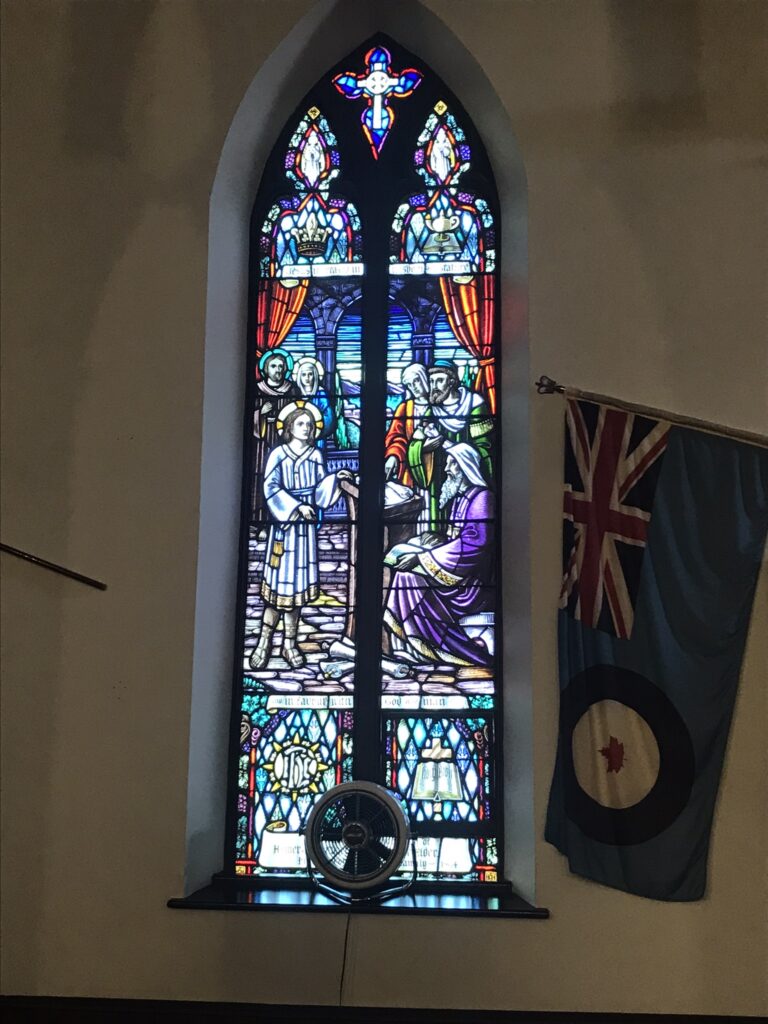
3. The Paul Window was installed in 1956.
This window was donated Mrs. L.M. Paul in memory of her husband, W.R. Paul, and daughter Aileen.
The kite shows a sword, a symbol for God’s Word, with the words faith, hope and love, the three primary expressions of Christian faith. Below and to the left, there is a cross with a loop at the top and a lamp; the cross signifies eternal life and the lamp, the wise illumination of Christ. To the right are two Christograms: Chi-Rho, from the first two Greek letters of Christ (ΧΡΙΣΤΟΣ) and Chi-Nu, from a Greek phrase meaning “Christ conquers.” The main portion of the window shows the risen Lord speaking to Saul (later St. Paul) after they met on the road to Damascus. At the bottom, there is a cherub on the left and a seated lamb with banner on the right. The lamb and banner refer to Jesus, the victorious Lamb of God; the seated position adds the additional meaning of the suffering and burden-bearing Christ.
4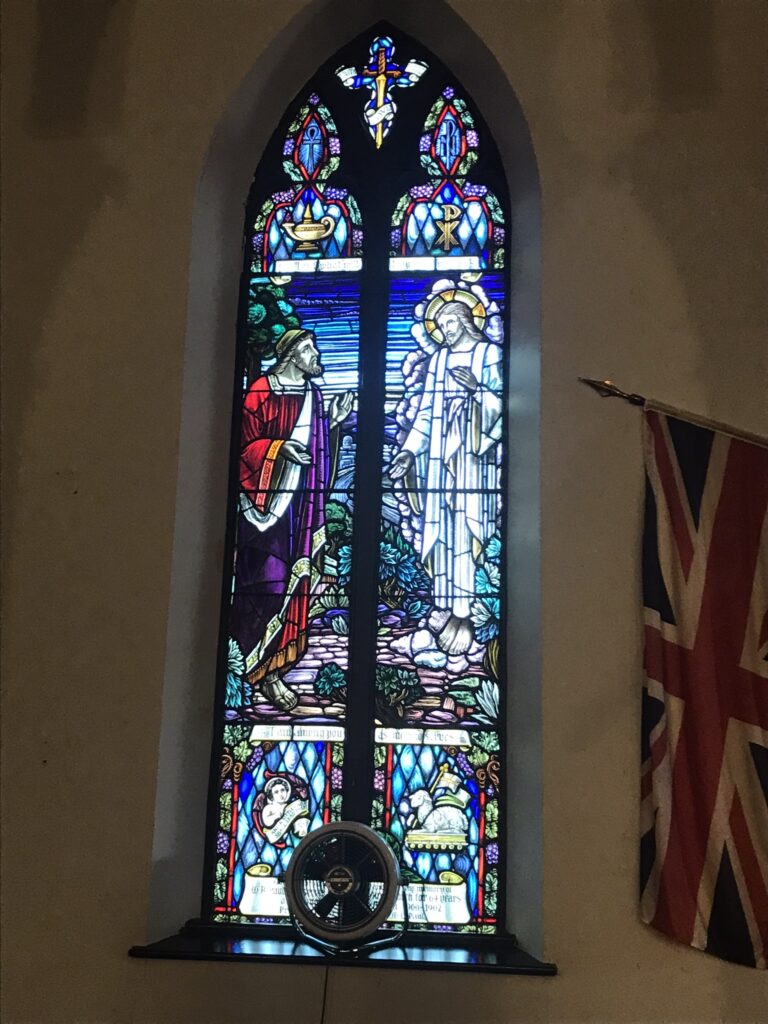
4. The Carruthers Window was installed in 1952.
This window was donated in memory of Mr. and Mrs. Herbert James Carruthers by their sons, Drs. W.B. and C.M. Carruthers. In the kite section of the window, there is a descending dove, symbolizing the Holy Spirit, who brings peace and the indwelling presence of God. The Christograms IHC and Chi-Rho are also present, referring to the Greek names Jesus and Christ, respectively. There are two angels; one holds a banner inscribed with “faith.” The main portion of the window shows Christ healing the sick who came to him: old and young, men and women. At the bottom left, there is an open Bible, the Word of God and our source of life, as well as the Greek letters for Alpha and Omega, a name for Jesus. To the right, an anchor and shield. The anchor symbolizes hope, salvation, stability and tranquility; the shield, our protection, is a sign of faith.
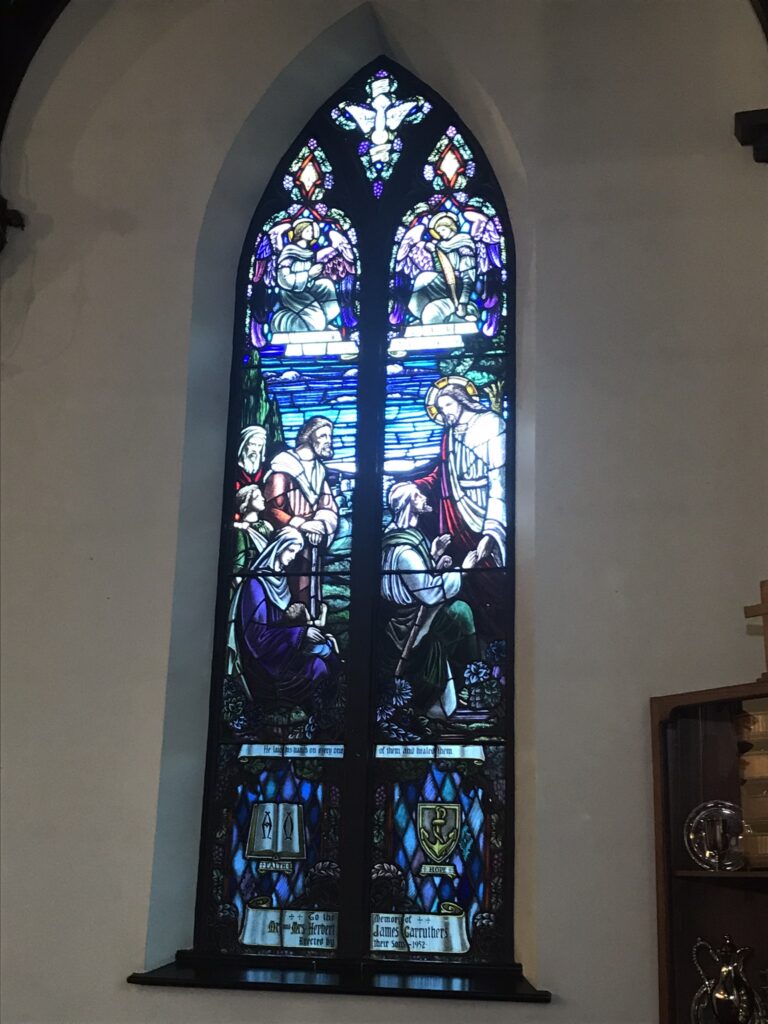
5. The Watson Window was installed in 1952.
This window was donated to honour Miss L.A. Watson’s 58 years of service in the Sunday school. The kite section shows a burning bush, signifying the presence of God with his people, who, like the bush, are not consumed by the fire. It has been a symbol of the Reformed Protestant tradition since 1583 and was adopted by the Presbyterian Church in Canada at its inception. There is also the four-pointed Star of Bethlehem, the shape of which also alludes to the Cross, and a descending dove. The main portion of the window shows Christ with the children. In offering him flowers, and sitting on his knee and at his feet, the children demonstrate their certainty of Jesus’ love for them. In the bottom panel, there is an eight-sided baptismal font, a bunch of grapes and a communion cup. Together, they symbolize important steps on the Christian journey from infancy to maturity in the faith.
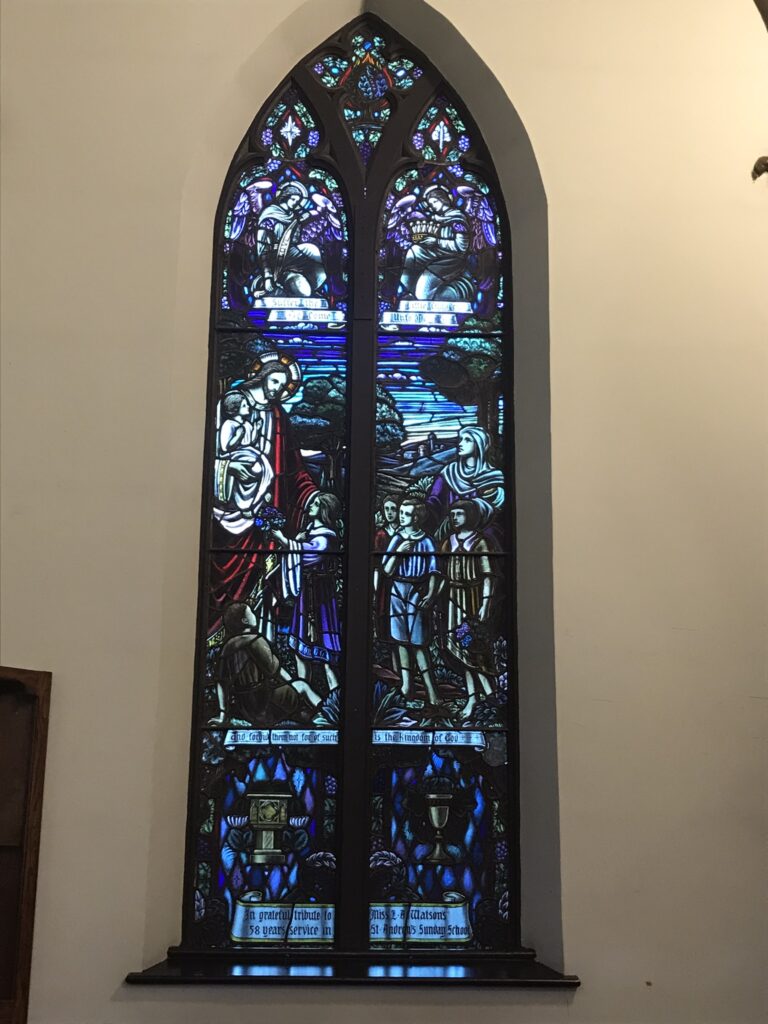
6. The Thomson Window was dedicated on November 17, 1985.
This window was donated in memory of Marie Thomson by her husband Clayton Thomson. The kite shows St. Andrew’s Presbyterian Church. The human family – man, woman and child – are in close relationship with God and with each other. They illustrate the oneness, or unity, found in Christ. Their nourishment comes from the bread or ‘body’ of Christ, and from the cup, Christ’s ‘blood,’ a sacrifice for all. Also incorporated into the design are the vine, symbolizing Christ who is our source of life, and the grapes. Together, with the wheat, they remind us of Christ’s sacrifice and our spiritual union with him and each other, as celebrated in the Sacrament of Communion.
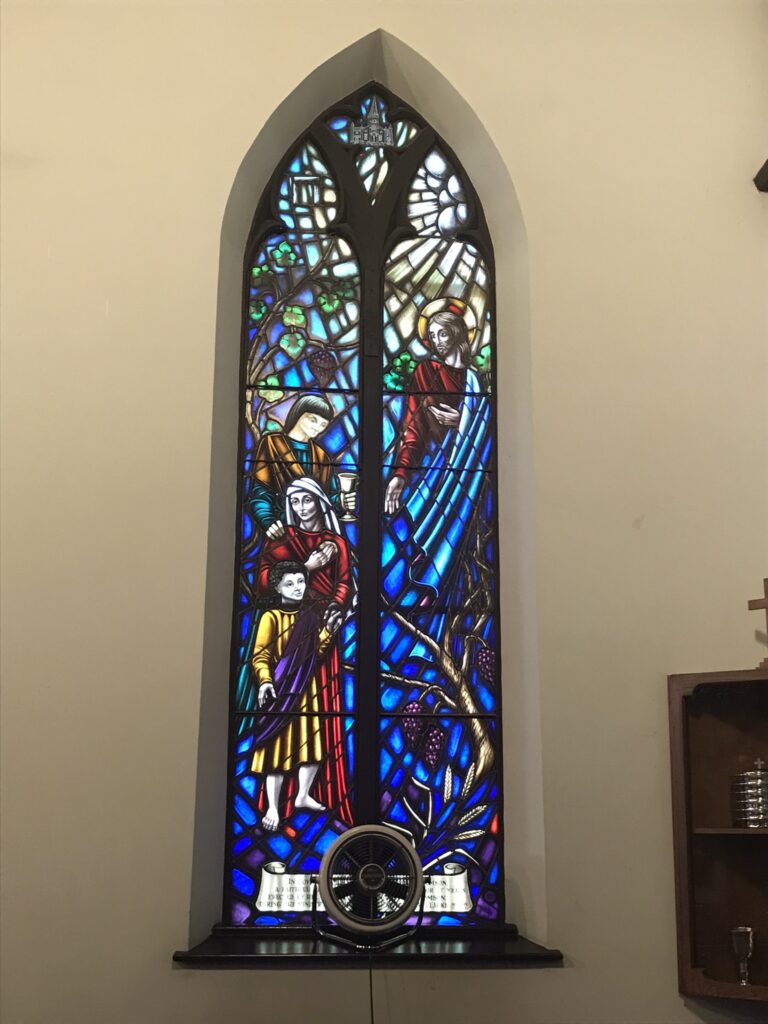
7. The MacLean/Leys Window was dedicated on September 9, 1963.
This window was donated by Donald MacLean in honour of his parents, Dr. And Mrs. Archibald MacLean, and grandparents, Mr. and Mrs. Alexander Leys. The kite shows the Chi-Rho symbol, which refers to Christ’s name in Greek. Below, the ancient symbols for St. Andrew (an X-shaped cross) and St. Peter (the keys to heaven) are shown. Two winged messengers from God are shown at the top of each panel. The main portion of the window shows the two brothers, Andrew and Peter, who were fishermen. They were among the first to follow Jesus and become his disciples, and are shown here with Christ. At the bottom of the left panel is a fish with the Greek word ἸΧΘΥΣ, an anagram of the phrase: “Jesus Christ, Son of God, Saviour” and denoting a disciple or follower of Christ. On the bottom right, there is a lantern. It is a symbol of Christ, the light and life of the world, and of our calling, which is to follow and witness to him.
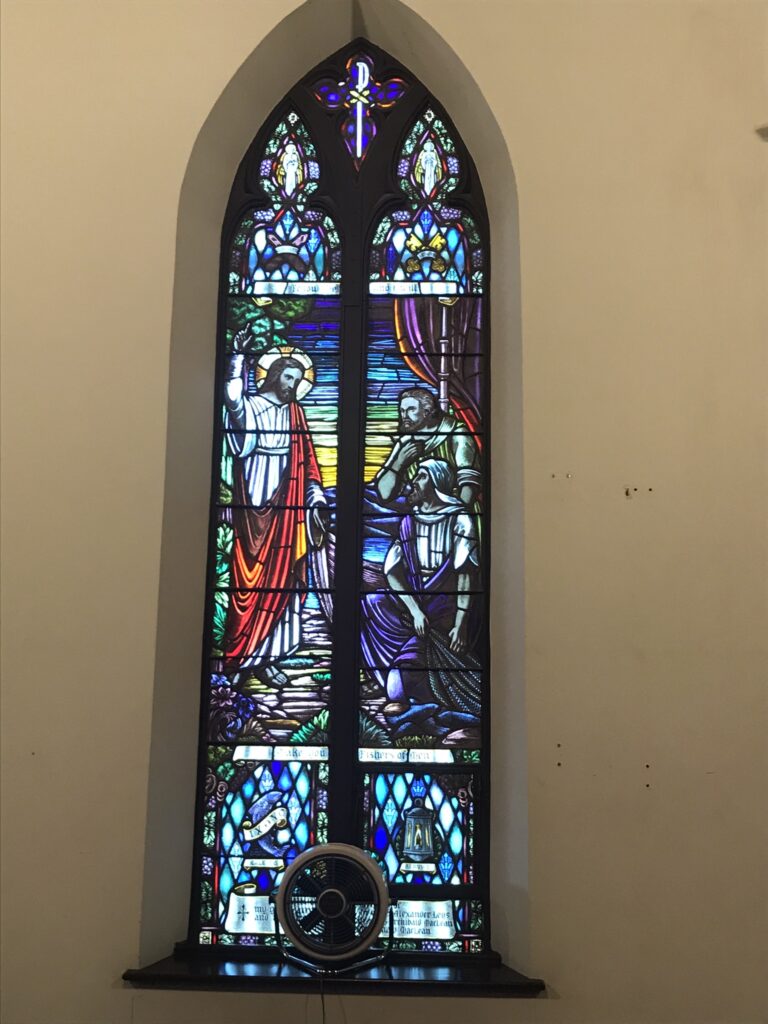
8. The Mackenzie Window was dedicated on June 30, 1963.
This window was a gift from the Mackenzie family in memory of Charles and Edith, their parents. The top section shows the Christogram, IHC; the crown of kingship and victory; a cross; and a sheaf of grain, symbolizing Christ, our bread of life. The main portion of the window shows Jesus, the Good Shepherd, caring for his sheep. At the bottom right, there is a nesting pelican. An old legend tells that a pelican will feed her young with her own blood in times of famine, and is thus a symbol of Christ and his atoning death for us on the Cross. At the bottom left, the crown and anchor symbolize of our reward for a faithful Christian life and Christ’s kingship, and our sure hope in Christ, respectively.
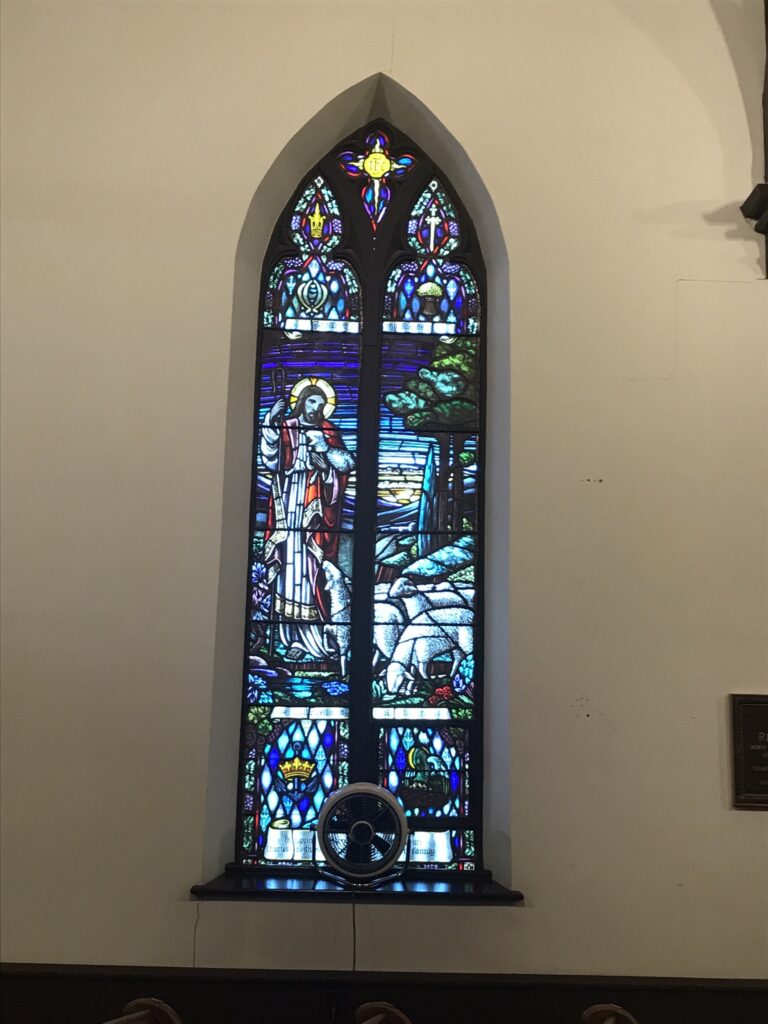
9. The Belton Window was dedicated on November 21, 1965.
This window was donated in memory Grace Doherty Belton by her husband Chester H. Belton and family. The kite section shows the five-pointed Epiphany star, which represents the coming of Christ to the world. Superimposed over it. Is the four-pointed Star of Bethlehem. Immediately below, there are two winged Cherub faces; the top left panel contains a stem of lilies, a symbol of Easter, and the top right, the downward rays of the Epiphany Star directed toward humanity. The main portion of the window shows the Magi bringing their gifts to the infant Jesus: gold, for his kingship; frankincense, for his priesthood; and myrrh, for his burial. Mary, Joseph and several animals are also pictured. At the bottom left, there is a gathering of angels. At the bottom right, a ship at sea symbolizes the church tossed about by the storms of history, but it is led safely through by the Bethlehem Star.
